| Good morning. We hope you enjoyed yesterday's special newsletter on the coronavirus vaccine supply chain. But that was just Part 1. Today we bring you Part 2, which focuses less on the physical materials and more on the humans. Let's set the mood with this passage from The Economist: "Deliverance, when it arrives, will come in a small glass vial. First there will be a cool sensation on the upper arm as an alcohol wipe is rubbed across the skin. Then there will be a sharp prick from a needle. Twenty-one days later, the same again. As the nurse drops the used syringe into the bin with a clatter, it will be hard not to wonder how something so small can solve a problem so large." | |  Giphy | Reality check: There won't be enough Covid-19 vaccines for everyone for a while. Probably years. Thankfully, the CDC has some rules so distribution won't look like a run on the Hunger Games cornucopia. Once a vaccine is approved by the FDA, the CDC's Advisory Committee on Immunization Practices will hold an emergency meeting within 48 hours to finalize recommendations around who gets the first shots. That guidance will be given at the national scale, which means state health officials will be left to figure out the nitty-gritty details of where the vials are going. - As we saw early in the pandemic with various lockdown measures, approaches by states can vary.
Who's first? The U.S.' ~20 million healthcare workers, including doctors, nurses, and support staff, will likely be top priority. Three other groups are widely considered to be especially vulnerable to the coronavirus: - The elderly (about 50 million Americans ages 65+)
- People with underlying conditions (80–100 million)
- Essential workers (40–60 million)
That's a lot of millions, and definitely more than we'll have vaccines for at first. Even people who qualify for priority vaccination will contend with limited supply. Some public health experts have also argued for early vaccinations for racial and ethnic minorities, who've experienced higher rates of coronavirus infection and death. And the children? Pharmaceuticals are, for good reason, not tested on kids first, and it'll take longer to get a vaccine approved for the youths. Only a few companies, including Pfizer, have started pediatric trials. Other factors to consider #1: Different vaccines have different logistical challenges and health considerations, which could affect who gets what when. Some vaccines may be better suited for the elderly, people with heart conditions, or pregnant women. Single-dose vaccines and ones that don't require ultra-cold storage can reach rural communities more easily. #2: Is the goal to limit spread or deaths? Before the swine flu pandemic, the strategy was to vaccinate the most vulnerable first. But in 2009, researchers published a study suggesting a focus on vaccinating the biggest spreaders—in the case of swine flu, children ages 5–19—to protect everyone else. - It helped, and now CDC guidance advises annual flu shots for kids six months and older.
#3: Not everyone will get a vaccine. In the last decade, the U.S. has never vaccinated more than half of adults for the flu, and vaccination rates for Black, Latinx, and high-risk adults trend lower. | | | If you thought state bidding wars for ventilators were ruthless, wait until you learn about the global competition for coronavirus vaccines. The Duke Global Health Institute estimates 9.6 billion doses are already reserved by individual countries, without any vaccines having reached the market yet. The early leaders? Wealthier countries. - The U.S., UK, EU, Canada, and Japan have secured 1.1 billion shots of Pfizer's vaccine, roughly 85% of planned production through 2021.
- Moderna's first 20 million doses will head to the U.S., which has a contract for 100 million.
Governments were hedging bets by investing in multiple vaccine candidates. But some have struck enough deals that, if multiple vaccines get regulatory approval, they could control a big chunk of supply. For instance, Canada could end up with enough doses to vaccinate its population 5x over. 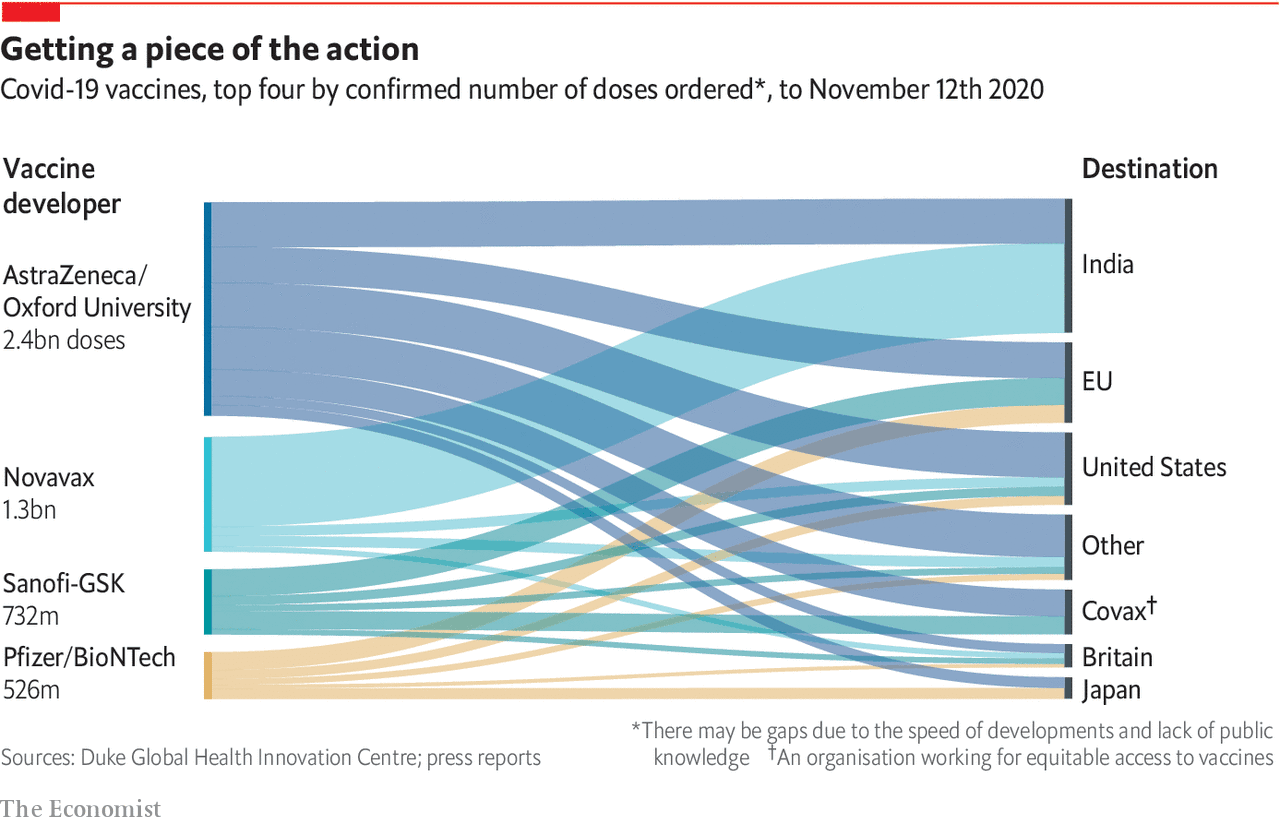
Economist That's a bit lopsided Which is where Covax comes in. This WHO-led initiative is working to ensure equitable vaccine access across the world. How it works: There are 184 countries participating, with wealthier countries subsidizing vaccine access for 92 lower- and middle-income ones, particularly across Africa and South and Southeast Asia. The goal is to raise $5 billion and provide 2 billion doses by the end of 2021. - So far, Covax has secured 700 million doses and $2 billion in funding.
- The U.S. is not currently participating; President-elect Joe Biden hasn't said whether his administration will join.
Pharma companies AstraZeneca, Johnson & Johnson, Novavax, and Sanofi plan to produce 3 billion doses for developing countries—some through Covax. Big picture: The Duke Global Health Institute thinks it'll take until 2024 for vaccines to reach the entire population. In that time, vaccines could be a new front in geopolitics. | |  Giphy | Or don't. In a Gallup poll this month, 42% of U.S. adults said they would not get an FDA-approved coronavirus vaccine. That's down from a peak of 50% in September, but remains a concerning number for public health officials who want to get Covid-19 under control. There are several reasons why the public's confidence is cracking harder than an iPhone screen on concrete. - 37% of respondents who said they wouldn't get vaccinated are worried about a rushed timeline.
- 26% want to wait until they confirm it's safe.
- 12% don't trust vaccines generally.
That's despite nine pharmaceutical companies, including frontrunners Moderna and Pfizer, pledging to hold their products to "high ethical standards and sound scientific principles." - Dr. Fauci has also tried reassuring the public that the process "did not compromise at all safety nor did it compromise scientific integrity."
Zoom out: At the very end of the Covid-19 vaccine's supply chain are injectees, and the WHO estimates 60%–80% of them need to be immune for a population to hit herd immunity. Establishing public trust in these vaccines will be the next major challenge for health officials. | |  | You've heard of the iconic "No Pants Dance." But FOR THIS WEEKEND ONLY, there's a new sheriff in Pants Dance Town: THE HALF-OFF PANTS DANCE. Mugsy makes the world's most comfortable jeans, and when you buy a pair this weekend, you get another pair half-off. We're Half-Off Pants Dancing for joy. Why? In addition to being ridiculously comfortable, Mugsy's high-tech fabrics are super stretchy and breathable, giving you a fit that's not too baggy and not too tight. With free shipping, returns, and exchanges, you've got nothing to lose. So get movin', get groovin', and snag some Mugsy jeans. | | | For U.S. businesses that have been WFH since March, the recent positive developments around vaccine trials landed as an opportunity to get the gang back together. Employers could simply ask all of their employees to get vaccinated, return to the office, and bid adieu to Zoom's 40-minute cutoff forever. But can employers legally require their workers to get vaccines? Short answer: Yes.* *There are exceptions for people with disabilities or those with "sincerely held" religious beliefs against vaccination. - Labor and employment attorney Michael Roche told Business Insider that the safest legal tack is for companies to "strongly encourage employees to get vaccinated."
- If an employer did require vaccination, it might mean assuming liability for any nasty side effects.
Instead, labor and employment lawyer Jay Rosenlieb advises companies to a) let workers get their shots on company time b) make sure everyone knows senior leadership got poked and c) if the company has a union, ask its leaders to encourage vaccination. | | Dublin, 19th Century: Touting the "Pneumatic Shield" 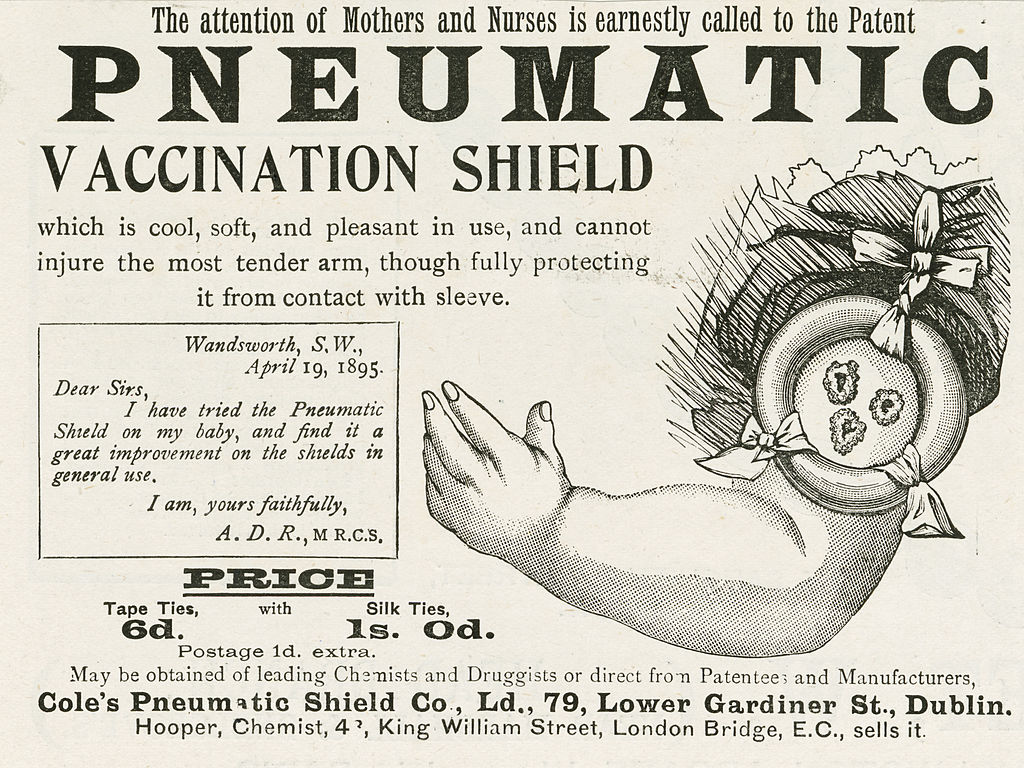
Universal History Archive/UIG/Getty Images
France, 1895: Buff army recruits being vaccinated for cowpox 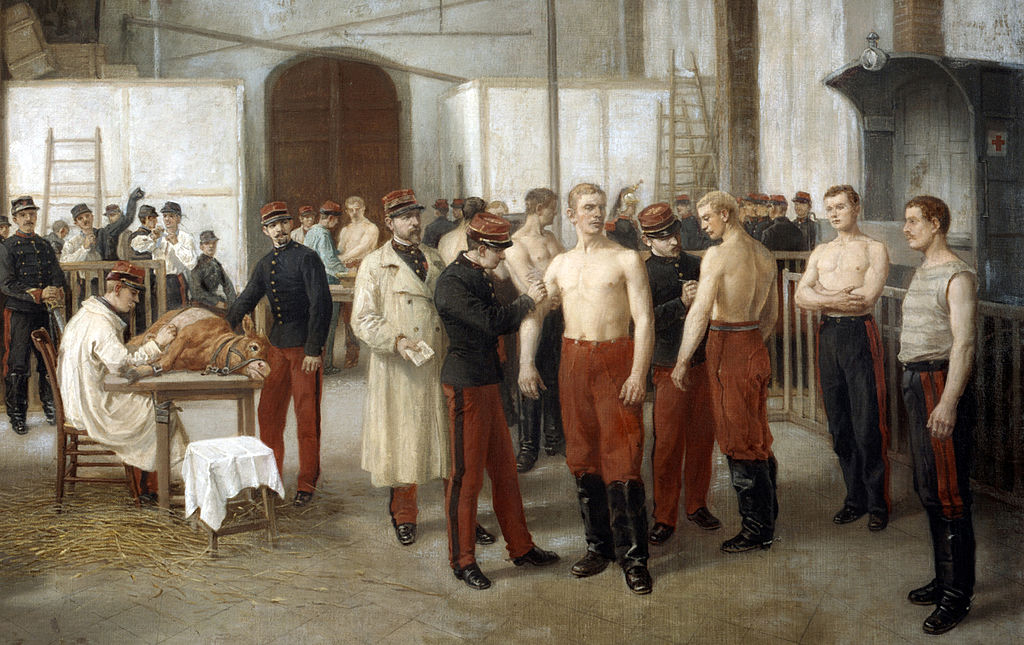
Universal History Archive/UIG/Getty Images
England, circa 1754: People were a little skeptical of the smallpox vaccine 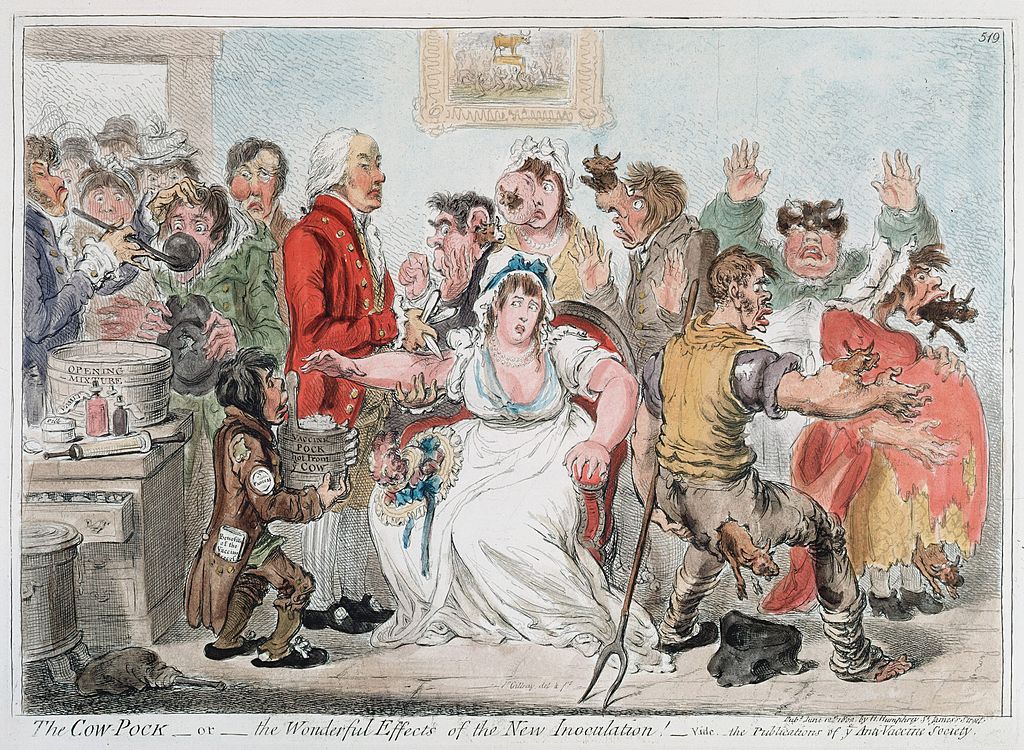
Universal History Archive/Getty Images
New York City, 1944: Get your shots, kids 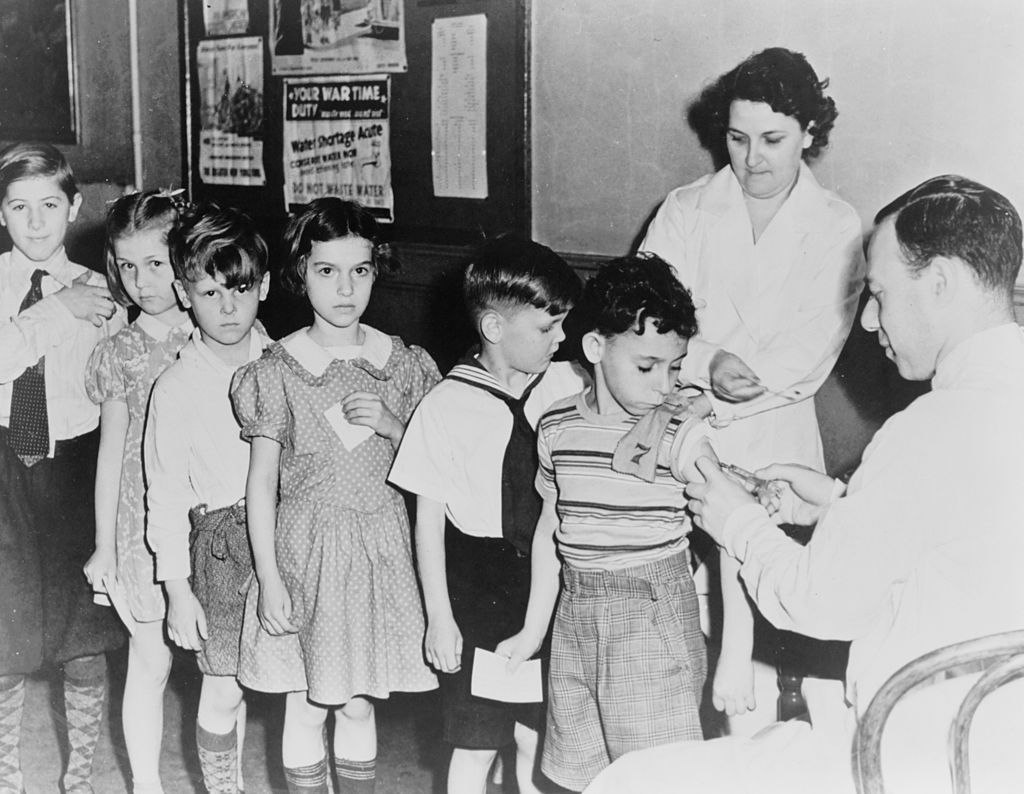
Universal History Archive/Universal Images Group via Getty Images
| |  Francis Scialabba | It's the question we've been asking since March: When will life return to normal? Finally, a rough timeline is beginning to take shape. Here's the best of all scenarios: December 12: The first immunizations could happen, according to the head of Operation Warp Speed, Dr. Moncef Slaoui. He said he expects about 20 million Americans to get vaccinated during the month. January 31, 2021: About 50 million Americans could be vaccinated by now, and, grouped in with those who've recovered from Covid-19, over 30% of the population would be immune, per the dean of Brown's public health school, Ashish Jha. February/March: At 30%–40% immunity, according to Jha, the spread will become "meaningfully slower" and infections won't be "self-sustaining." April/May: With a widely available vaccine, late spring is when we could see the pandemic truly wind down and life return to what we might call "normal"—but what that even means is still unclear. Bottom line: While actually seeing this timeline on paper is enough to make your heart skip a beat, experts warn the next few months will be challenging for controlling the spread of Covid-19. Masks, social distancing, and other pandemic-era public health measures will be necessary as vaccines are rolled out. | | SPONSORED BY COMPARECREDIT™ | | | The Brew Crossword is off this week for the holiday. But we've still got a fun trivia question for you. The premise: A lot of car models are named after places. We'll give you a car model named after a place, and you have to figure out the car brand that makes it. - Durango
- Tahoe
- Sedona
- Santa Fe
- Tacoma
| | | It only takes 3 referrals to earn access to Light Roast, our exclusive Sunday newsletter. Just the right amount of Brew to go with your lazy Sunday morning. You don't even need to train the dog to fetch it from the driveway. 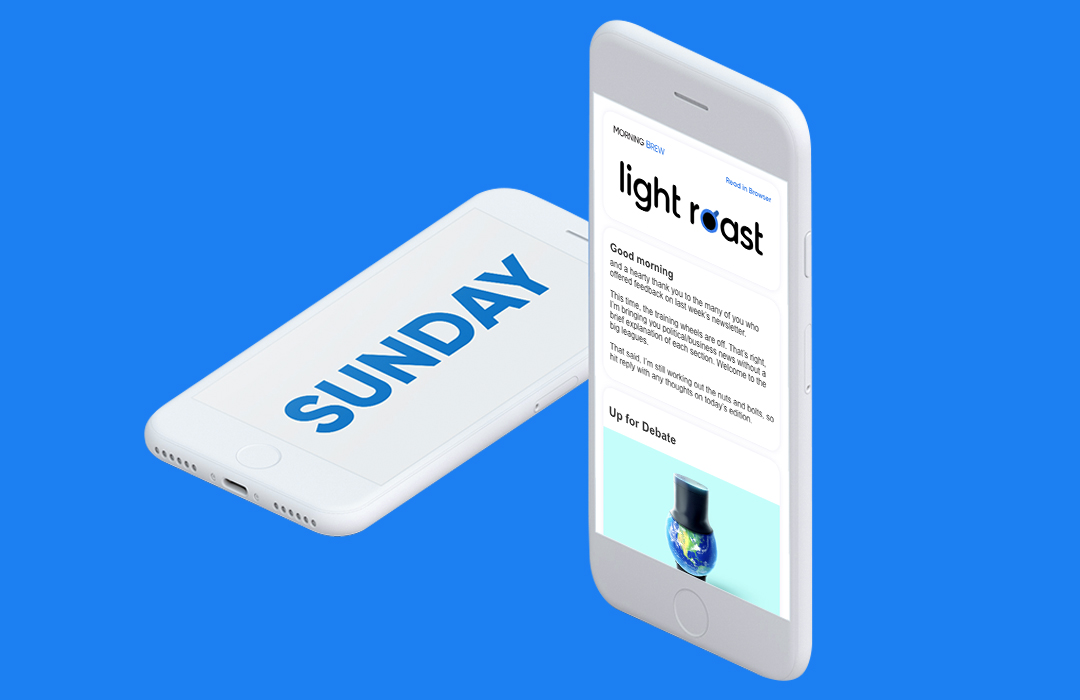
Hit the button below to start sharing the Brew. Click to ShareOr copy & paste your referral link to others:
morningbrew.com/daily/r/?kid=8386977e | | - Dodge Durango
- Chevy Tahoe
- Kia Sedona
- Hyundai Santa Fe
- Toyota Tacoma
| | |
















No comments:
Post a Comment